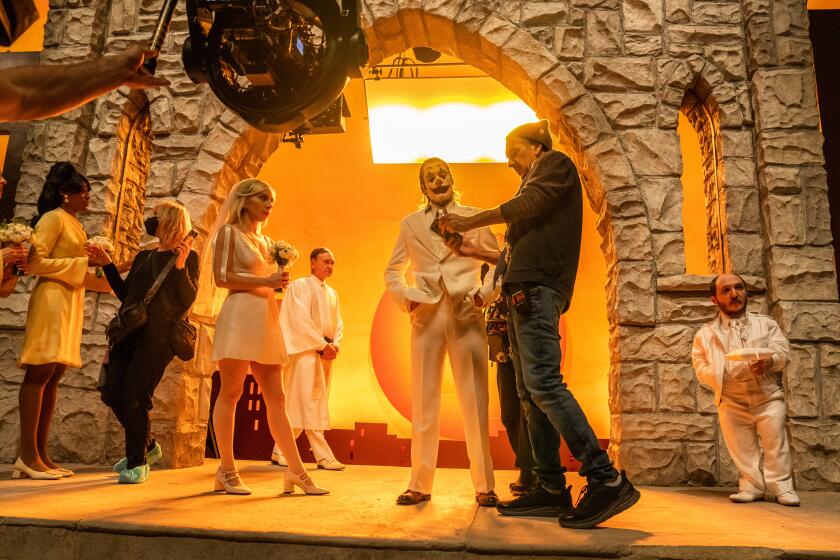Film review: ‘The Oath’
There is a telling moment about midway through Laura Poitras’ riveting new documentary “The Oath,” an intimate portrait of Osama bin Laden’s former bodyguard, Abu Jandal, and Salim Hamdan, Bin Laden’s driver, who spent years jailed at Guantanamo Bay.
By this point in the film, Jandal seems familiar, an articulate and insightful man, cleverly ironic, candid about his Al Qaeda allegiance, a gentle father to his son, a religious man, not the thug his terrorist affiliation would suggest.
And then he lies. So easily, so believably, it comes like a slap in the face. It’s not a big lie. He’s just soothing a nervous passenger in the taxi he now drives in Sana, Yemen, explaining away the camera the filmmaker has set up on the dashboard. It’s for a story on taxi drivers; it’s broken; no worries. And yet.
Finding and using moments like that are Poitras’ great skill; they tell the story without her intervention. Of course, she is very much there, in the picking and choosing and especially in having the patience to wait for the moments to emerge in their own time, to say nothing of the remarkable access she manages. But the hands-off style allows the scene to resonate on its own. She leaves it to the rest of us to decide what and whom to believe.
Thus far, that distance has proved a saving grace for the trilogy she’s assembling on America post Sept. 11. A heavier hand would make it easier to turn away instead of being drawn in. “The Oath” is the second in the series and took home the top cinematography prize at Sundance this year. The first, “My Country, My Country,” a view of the Iraqi occupation through the eyes of a local doctor turned political activist, was nominated for an Oscar in 2007.
In both, the filmmaker uses scenes from the world in which her subjects live to set the context. The busy streets of Sana, the bare apartment where Jandal’s family lives, the room where young men question him about jihad, where he and his son say prayers, define Jandal’s world. He was briefly in custody, his information about Bin Laden’s operation deemed significant enough to buy his freedom and the taxi.
Just how deep inside Jandal’s world Poitras goes is all the more striking given the inherent cultural barriers and danger she faced as a female filmmaker shooting a former Al Qaeda operative in Yemen. The cinematography credit is shared with another female filmmaker, Kirsten Johnson.
Hamdan we never see beyond a few family photos and the grainy video of him soon after his capture two months after the World Trade Center attack. He is on his knees, hands bound behind him, a sack over his head, U.S. soldiers standing nearby. Poitras introduces us to his time in Guantanamo with shots of the solitary compound, a bird circling high above the chain-link fence surrounding it. We hear of his isolation, his fears through excerpts from his letters home. We hear the arguments on whether or not he’s a terrorist from prosecutors, his attorneys and trial transcripts.
In telling Hamdan’s story, Poitras relies on the basic facts, which she sets out with a combination of title cards and news conference clips. Step by step, she takes us through Hamdan’s first military tribunal, which led to the landmark case Hamdan vs. Rumsfeld with the Supreme Court ruling in his favor that Geneva Conventions and international POW laws had been violated. Then Congress’ reaction, redrafting a law so Hamdan could continue to be held and recharged. And, finally, Hamdan’s trial, modest conviction and release in 2009.
As much as Poitras is setting out Jandal and Hamdan’s stories, she is also laying out U.S. actions, particularly in regard to Guantanamo, for our assessment. Especially compelling are the news conferences with Hamdan’s prosecutors and defense attorneys — both sides drawn from the U.S. military — matter of factly laying out their case.
Jandal emerges as someone who was truly in Bin Laden’s inner circle, Hamdan seems the menial driver he claimed to be. What remains unanswered is where their allegiances now lie. Frightening or not, terrorists or not, both seem human, which at the end of the day is what Poitras set out to do.
Clicking on Green Links will take you to a third-party e-commerce site. These sites are not operated by the Los Angeles Times. The Times Editorial staff is not involved in any way with Green Links or with these third-party sites.
More to Read
Only good movies
Get the Indie Focus newsletter, Mark Olsen's weekly guide to the world of cinema.
You may occasionally receive promotional content from the Los Angeles Times.











